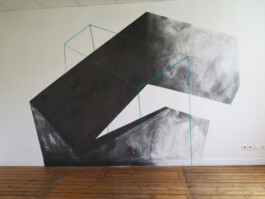
Here & Above, Le Radar, Bayeux
Espace Fragmenté
2 levels wall-drawing, mixed media, 5 x 3,4 m
dessin mural sur 2 étages, techniques mixtes, 5 x 3,4 m
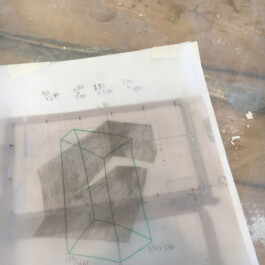
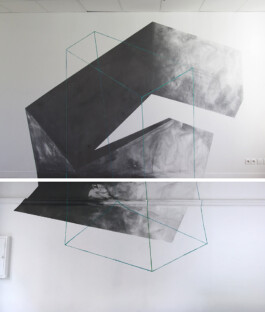
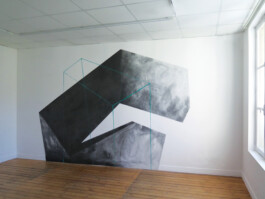
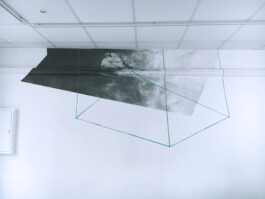
If we consider that the environment is perceptible only in isolation then, of the world, we record only a fragmented, split up vision.
When Réjane Lhote tries to tame the spaces that surround her, she is inevitably forced to adopt a point of view, to operate a selection. She first scans the location, X-rays its internal skeleton and records the way it is arranged. Next, she opens up and unfurls the walls, lays them bare, exposing them flat on paper. The topography of theses places is then declined in a repertoire of forms.
Visible in sketchbooks, the forms are later transposed to the scale of a wall drawing.
These signs have the appearance of dense black shapes, the sharp edges face the empty white walls. These representations of fragmented spaces are fragile, in tension, they threaten to break. In this sense, Réjane Lhote's drawings falter between synthesis and possible dislocation. They arise from strategies of spacings, from gaps and from inversions. The form which it gives to see on two levels is on the edge, suspended, and dizziness is watching us. The spectator thus experiences this paradoxical situation which consists in discovering in two phases a drawing that unfolds on two spaces.
Justine Richard
Si l’on considère que l’environnement n’est perceptible que de manière isolée alors, du monde, nous n’enregistrons qu’une vision parcellaire, fragmentée.
Lorsque Réjane Lhote tente d’apprivoiser les espaces qui l’entourent, elle est nécessairement contrainte d’adopter un point de vue, d’opérer une sélection. Elle scanne alors le lieu, radiographie son squelette interne et enregistre la manière dont il s’agence. Elle décloisonne et déploie les murs, les met à nu, les couche à plat sur le papier. Cette topographie des lieux se décline en un répertoire de formes. Visible dans des carnets à dessin, elles sont ensuite transposées à l’échelle d’un dessin mural.
Ces signes prennent l’aspect de formes noires très denses, dont les arrêtes tranchantes se heurtent au vide des murs blancs. Ces représentations d’espaces fragmentés sont fragiles, en tension, elles menacent de rompre. En ce sens, les dessins de Réjane Lhote vacillent entre synthèse et possible désarticulation. Ils naissent de stratégies d’espacements, de décalages et d’inversions. La forme qu’elle donne à voir sur deux niveaux est au bord, en suspend, et le vertige nous guette. Le spectateur expérimente ainsi cette situation paradoxale qui consiste à découvrir en deux temps un dessin qui se déploie sur deux espaces.
Justine Richard